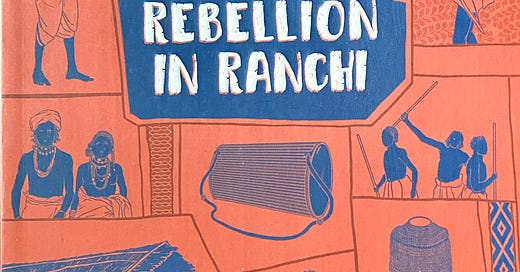“Rebellion in Ranchi” by Swati Sengupta. Published by Duckbill. A compelling story about the lesser known Tana Bhagat movement to protest against the injustice meted out to the Oraon tribals from the Chota Nagpur region by the British Raj and the zamindars.
The narrator of the story is its protagonist Sibu, a young boy living in Chingri village which is part of Ranchi district. The year is 1915. Sibu belongs to the Kurukh or Oraon tribe from the Chota Nagpur region. The Oraons had spent many decades clearing the forests in this region and making the land fit for cultivation. Now they were ruled by Englishmen through the non-adivasi zamindars who collected huge amounts of taxes from them for farming the land. Losing most of their meagre earnings in these taxes, they ended up neck deep in debts. To add to their misery, the interest rates for the loans that they took from the moneylenders were also very steep. Struggling between these payments, they never had enough money to survive. They ended up migrating to find other kinds of work like building roads or working in mines and tea gardens.
Sibu lives with his parents and grandmother. His best friend Budhu who is also a distant relative lives next door. Life had been idyllic for the two boys so far despite the misery and difficulties that their community faced. But change was all around them. It started with rumours of German Baba or Kaiser who would defeat the British in the Great War being fought in a distant land and help them. They would finally be free from the British. The adults from their community were becoming part of the non violent Tana Bhagat movement protesting against the zamindars and their unfair taxes. Sibu and Budhu find themselves trying to make sense of what is happening around them. Life is not going to be the same any longer. Read the engrossing book to know more about what happens to Sibu and the Tana Bhagats.
This coming of age story of Sibu from a tumultuous period gives a vivid glimpse into the hard lives of the Oraon tribals. Their living conditions and their lack of knowledge of the outside world was quite hard to imagine. Despite being weighed down by superstitious beliefs and waiting for someone to come to their rescue, the tribals did end up becoming a part of the freedom movement. Having already read the story of Birsa Munda from the same region who lived in the late nineteenth century by the same author, my ten and a half year old and I were aware of the miserable conditions of the tribals in the Chota Nagpur region. However the Tana Bhagat movement was something that we had not heard of. This clearly is a forgotten chapter from history and the book is an excellent means to know about it. Another highlight of the story is its endearing characters. The heartwarming bonding between Sibu and his grandmother Eng Ajji has been portrayed wonderfully. The book is a part of the “Songs of Freedom” series which is one of our favourites. The series explores how the lives of children across India might have been during the struggle for Independence.
Recommended Age
The book is apt for children aged 10 and above.
P.S. - The other books from the series that we have read and enjoyed so far are “The Chowpatty Cooking Club”, “That Year at Manikoil”, “The Train to Tanjore”, “A Conspiracy in Calcutta”, “The Letter to Lahore”, “Postcard From the Lushai Brigade” and “A Melody in Mysore”.
Disclaimer - We received this book from the publisher, Penguin India (Duckbill), for review. Thank you to Mansi, from Penguin, for sending across the book!





